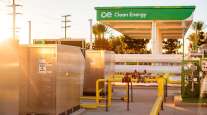Natural Gas Takes Center Stage at Mid-America
This story appears in the March 26 print edition of Transport Topics. Click here to subscribe today.
LOUISVILLE, Ky. — The nation’s largest annual trucking show here last week illustrated just how much the U.S. truck market has been reinvigorated, as more-prosperous equipment manufacturers eagerly chased the business of solid, stable motor carriers.
Several truck makers unveiled new vehicles and spoke of innovations to come during the first hours of the Mid-America Trucking Show on March 21 and March 22. But natural gas was the brightest star of the show, playing a role in the presentations of Cummins, Freightliner, Kenworth, Navistar and Peterbilt.
Kenworth Trucks and Peterbilt Motors, divisions of Paccar Inc., unveiled new trucks, with both makers showing sleeper and day-cab models.
Navistar Inc. rented five times more space in the Kentucky Exposition Center than ever before, as it brought most of its dealers and many of its biggest customers to the show to promote its truck lineup. Navistar also used the extra space to host a panel discussion on natural gas in trucking, featuring natural-gas investor and booster T. Boone Pickens.
Freightliner Trucks looked back on its 70-year history — captured in part by “White Freightliner Blues” by Townes Van Zandt — and forward, showing a sleek concept truck with unusual doors and cameras instead of mirrors.
Cummins Inc., the independent engine maker, emphasized its commitment to natural gas-powered engines, described a nanotechnology fuel filter and gave details on its engines to be manufactured next year.
Volvo Trucks also spoke of its success from last year and about plans for natural gas in the near future. The OEM said it will be an early adopter of the 2014 standards for greenhouse-gas emissions.
Volvo will use the Cummins-Westport 12-liter engine with natural gas. However, Volvo’s long-term goal is to work with Westport to develop its own 13-liter natural gas engine, said Ron Huibers, president of sales and marketing.
(Mack’s event at MATS occurred too late for inclusion in this story but will be covered next week in Transport Topics.)
“It’s a good time to be in the trucking industry,” said Bill Kozek, general manager of Peterbilt Motors and Kenworth’s former GM. Kozek said freight volumes are increasing, as are carrier profits, in part because fuel surcharges are sticking even as diesel prices rise.
Kozek introduced Peterbilt’s new Model 579, two versions of which drove onto the second-floor ballroom floor of the nearby convention center through a fog of dry ice.
Kenworth’s new truck is the T680, also in day cab and sleeper versions.
Under the skin, the two trucks offer similar engineering and aerodynamic improvements, but Peterbilt chief engineer Landon Sproull said their “see, touch, feel” design elements are different.
Both new trucks have widened aluminum cabs offering space between the front seats for easy access to the sleeper berth. Sproull said the Peterbilt truck has a detachable sleeper, while Kenworth’s sleeper is integrated with the cab.
Preston Feight, Sproull’s counterpart at Kenworth, said he would match his truck’s driver comforts against those of a Lexus luxury car.
Kozek scoffed at the notion the trucks might be called “posh” but did say that Peterbilt’s 579 would be priced at the top of the line. “It’s a premium price, but it will compete in the market,” he said.
Navistar executives want their International Trucks and MaxxForce engines to go in a different direction from other OEMs regarding natural gas power plants.
Cummins Inc. uses spark-ignition engines with pure natural gas, built by the Cummins-Westport joint venture. Navistar will offer this engine in its trucks but is also working on its own model, a compression engine using a 15% dose of diesel to ignite the natural gas.
Navistar said this new engine will be a variant of its 13-liter MaxxForce engine and will be available in the fall of 2013. The technology is called diesel-pilot injection, and it would become Navistar’s heavy-duty choice for natural-gas power.
Navistar, Lisle, Ill., said it also would use its current 7.6-liter DT natural gas engine with spark ignition and the 8.9-liter ISL G, also with spark ignition, from Cummins-Westport for lighter-duty applications.
Navistar engineer Nadine Haupt said a selling point of diesel-pilot injection is that the truck can run briefly on pure diesel in a “limp-home” mode, if need be. While natural gas is cheaper than diesel when comparing energy content, for now diesel is much easier to find on the road than natural gas (3-19, p. 5).
Navistar wants to emphasize natural gas, said Senior Vice President James Hebe, who noted his colleagues met with natural gas executives, including Pickens, beginning late last year and decided on an implementation strategy.
Cummins-Westport’s heavy-duty ISX 12G engine was on display at MATS in trucks by Freightliner, Kenworth and Peterbilt.
Cummins also said it is working on a 15-liter version of the engine without Westport and that this version could be ready for sale in about three years.
Cummins has the largest share of North America’s heavy-duty truck engine market, and officials said that at least 85% of its sales are the 15-liter ISX, although there are 12-liter and smaller models. While many truck makers have been recommending their in-house 13-liter power plants, Ed Pence, Cummins general manager of heavy-duty engines, said there is still strong demand for 15s.
“Rumors of the 15-liter engine’s demise have been greatly exaggerated,” Pence said.
Meanwhile, Freightliner’s concept truck was described as a “crossover” between day cabs and sleepers, or a day cab that occasionally could be pressed comfortably into sleeper duty, said David Hames, a general manager of Freightliner parent Daimler Trucks North America.
Not only is the truck not in production, however, it isn’t even street legal. The “Revolution” truck probably won’t come to market looking like it did on stage, Hames said, but elements of it are compelling and could end up being incorporated into production models.
The tractor features a regular driver-side door, a passenger-side door that is just an opening for loading luggage and other small items and a back-of-the-tractor door leading toward the fifth wheel.




